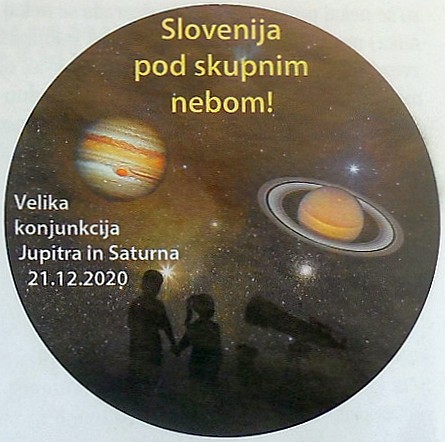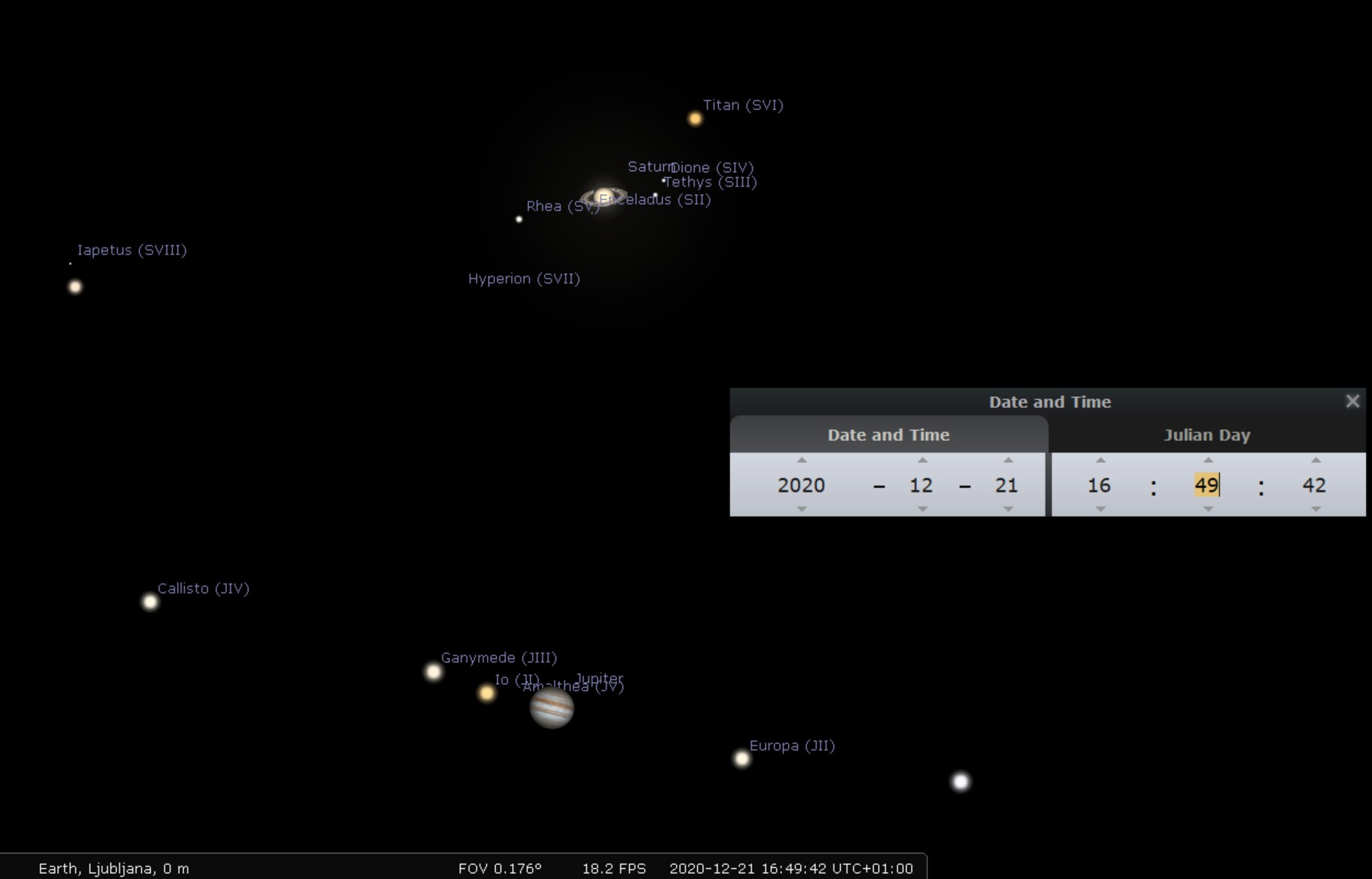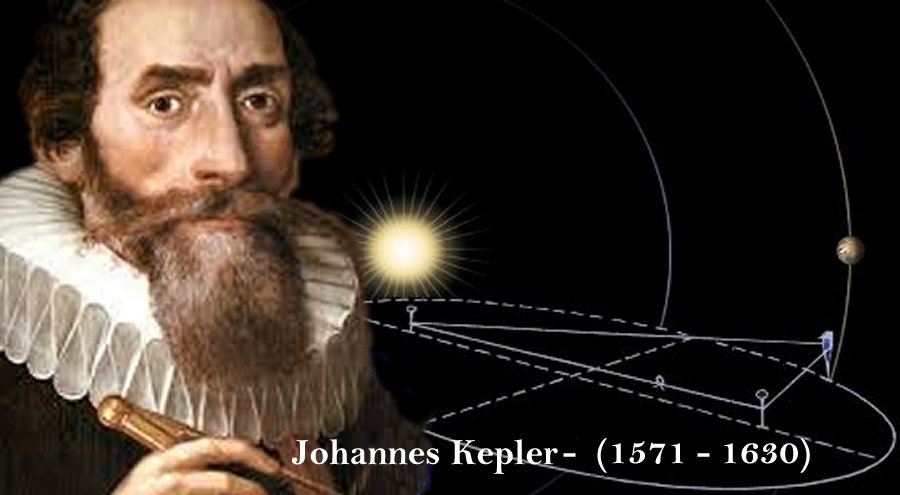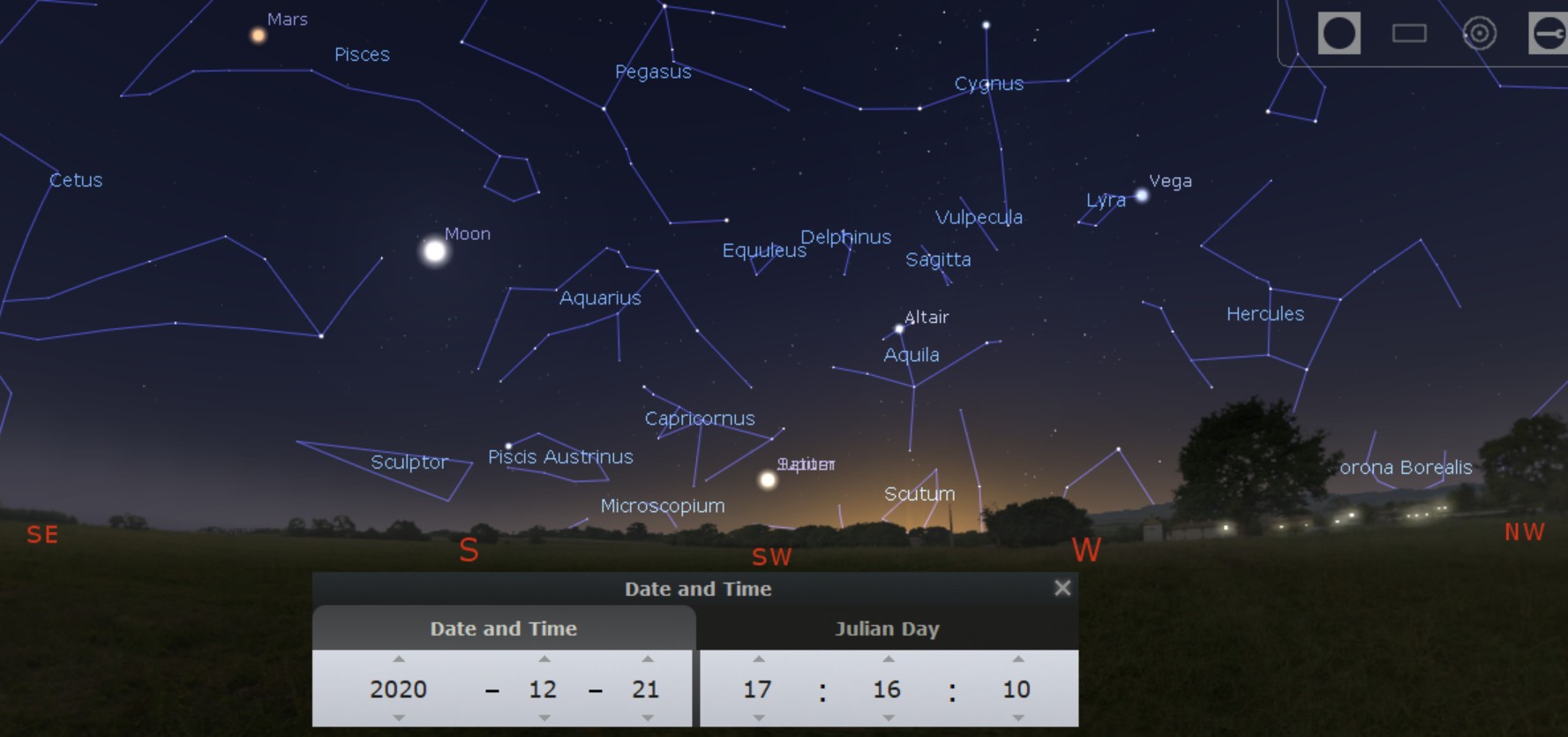We propose:
|

|
We propose:
|

|
In 2019 Millions of People Celebrated IAU's Centenary Under One Sky.
This year, the Slovenian astronomical magazine Spika (the editor is
physicist Mr. Bojan Kambič) will dedicate part of its space to Wanderers
(but not to the kings of the street, but the sky) [3].
Why?
At the end of 2020, the two largest "wanderers" will meet
quite close together, so close that they will be visible
together in a telescope's field of view, only 0.1° apart
(one-fifth the angular size of the Moon or half of the
angular distance between Mizar and Alcor, the famous double
star in the Big Dipper)! This Jupiter - Saturn conjunction
is the closest
Great Conjunction since 1623.
It's a view which can only rarely be seen in the sky, breathtaking,
inspiring and inviting us to see even more, to know even more.
We invite all of you, dear readers with telescopes, to organize a public
observation in your village, town, school, in your company, to share your
knowledge with fellow citizens, students, co-workers, friends, etc. Don't
miss this beautiful opportunity to promote astronomy and a dark sky!

Have you ever heard ofcelestial wanderers? Certainly you have- but under
a different name. Before we unmask these eminent celestial travelers,
potential hosts of life, let's review a brief history of observing the
sky - from the Sun, the starry sky, the Moon. At the same time, we will
emphasize the importance of celestial observations for the development
of modern society and culture. Despite the availability of astronomical
equipment and scientific literature, primary astronomical observations
are still not available to our children, practically are not included
in school programs. The primary astronomical observations of our
ancestors were built into the foundations of the modern world, let
us mention some:
the foundations of Kepler - Newton's mechanics of celestial bodies,
Einstein's theory of special/general relativity (Newton was "wrong",
so Einstein upgraded him), the foundations of space travel, satellite
technology, GPS navigation, all cosmological models (from birth to the
present development of the universe, to the origin of life, mankind,
to the strategy of our survival).
There have been many women and men
who have paved the way to our modern knowledge over the millennia,
mostly in connection with the planets. But let's mention only two
masters - out of all the others (both are connected with Europe
and also partly with Slovenia!).

The indelible foundations of modern astronomy were certainly laid by
the outstanding practitioner and theorist Johannes Kepler (1571 - 1630)
with mathematical descriptions of the motion of celestial bodies - and
this through observation (measurements) of the position of planets on
a stellar background (primarily of Mars, most of the measurements were
contributed by Tycho Brahe).
In 1619 he published his third law of planetary motion: The square of
the orbital period of a planet is directly proportional to the cube
of the semi-major axis of its elliptical orbit. Today we know that
the proportionality is largely determined by the mass of the Sun
and only partially of the small planet.
Kepler also spent a few months in the Kasteliče mansion, Petanjci - Prekmurje, today Slovenia (the reasons were in strong political tensions over economic dominance in society - of course under the pretext of one or another negligible difference in faith).
But - there is another reason, and basically the most important one, to dedicate this year to the planets. Life, and of course man, was created on a planet - on planet Earth - but we humans did not understand that for a long time. Why? That we ourselves live on one of the planets was not really so self-evident and easy to prove as some popular writers from comfortable armchairs claim today. And in this connection let us to mention another genius (somewhat less well-known in the natural sciences)?
Nicholas of Cusa (1401 - 1464) was probably the first person who authentically described the stars as distant suns and exoplanets traveling around them, and consequently allowed the presence of life far away in space (in his book from 1440 - "On scientific ignorance ", org. "De docta ignorantia" - he said that there are also inhabited worlds) this was exceptional. Cusa was a famous medieval polymath, theologian, bishop, cardinal, philosopher, mathematician, optician, astronomer, ecclesiastical expert, prisoner, humanitarian. He saved many people, refugees and most Greek ancient writings from the fallen Byzantium and was thus an active pioneer of the Renaissance (in 1458 he also visited Bled, Bohinj - presentday Slovenia). Today ("Nikola's") exoplanets are in the center of space research! Kepler knew Cusa's work very well and he called Cusanus 'Divinely Inspired' in the first paragraph of his first published work. We must, of course, understand these words in the context of the time.

Let's go back to the beginnings of astronomy. How did our ancestors even separate the planets from other stars? With systematic observations! And why did they do that? Because of the necessity in planning life - when with the development of civilizations (speech, writing, agriculture, etc.) time was organically introduced, a calendar that was based (and still is based today) on what was seen in the sky, on the celestial cycles. Because the events in the sky were unequivocally reflected in the natural cycle of the Earth (the seasons in connection with the annual apparent movement of the Sun and the changing appearance of the starry night sky). What has been said can be summed up in a simple statement - "both in heaven and on Earth".
The first civilizations thus needed a schedule of work, living and also spiritual rituals for a stable life. Spiritual rituals often reflected the first attempts to explain the origin of the universe - cosmology - they were awkward, but the first steps are always uncertain. And another important fact - the observation of the sky and thus the development of the calendar contributed to the introduction of the concept of time in the structure of language. Less well-known is the fact that there are still languages that do not contain verbal tenses (the speakers have a modest language, whistling, etc., they have no history, heroes, religion).
And what else did our curious ancestors notice, apart from the constant stars? The stars keep their patterns in the sky fairly permanently - they maintain a constant relative position to each other, despite the apparent daily and seasonal rotation of the sky. They also noticed something surprising, namely that some "stars" walk (move) between fixed stars, between stable stellar patterns - constellations.
This whimsical behavior of the planets can also be observed by each of us if, say, we sketch the starry sky every week (depending on the weather) and do so throughout the year or several years. Thus we indelibly perceive that the evening starry sky changes through the seasons, we perceive what the planets are (wanderers across the constellations), we can also estimate their orbital times, periods.
The Greeks described the planets with the very imaginative phrase "planetes asteres" ("wandering stars", the translation may also be slightly different, for example the traveling stars). Can you imagine reading a statement in Spika or in Europhysicsnews, Astronomy, Sky & Telescope, Sterne und Weltraum, ... for example - the wander Jupiter is in opposition (from a pedagogical point of view, does such a name make sense)? But practically all the languages of the world have in the end summarized (copied) the name of the celestial wanderers after the Greek word "planetai"! Together with the Sun and the Moon, the five planets visible with the naked eye make up the seven brightest periodically moving celestial bodies relative to the stars. The wanderers easily visible with the naked eye are Mercury, Venus, Mars, Jupiter, Saturn, according to their distances from the Sun. The third stone/planet (Earth) from the Sun is inhabited by humans.
Already the Babylonians adopted a seven-day week due to the
seven stray celestial bodies they observed in the sky. This
is another amazing fact about the extraordinary connection
of our culture with the ancient Babylonians and with the sky
wanderers.
The German name Sonntag or English Sunday points to the fact
that Sunday was dedicated to the Sun. The Italian names (as well
as similar French ones) lunedi, martedi, mercoledi, giovedi,
venerdi reveal that Monday was dedicated to the Moon, Tuesday
to Mars, Wednesday to Mercury, Thursday to Jupiter-Job, Friday
to Venus, and the English Saturday shows that that day was
dedicated to Saturn.
We mentioned at the beginning that primary astronomical observations
of ours have been built into the foundations of the modern world:
in Kepler - Newton's mechanics of celestial bodies, Einstein's theory
of special/general relativity, in the foundations of space travel,
satellite technology, GPS navigation, in all cosmological models
(from birth to the present development of the universe).
For example, let's see how Kepler's mechanics of planetary motion
helped us to detect dark matter, which is today an important part
of the theory of the origin and development of the universe.
In the 1970s Vera Rubin and Kent Ford measured with a spectrograph
the velocity curves of edge-on spiral galaxies [4]. From Kepler's
Laws, it is expected that the rotation velocities (v) will decrease
with distance (r) from the center mass (m) similarly to the Solar
System ( v ∝ (m/r)1/2 ). But the results were surprising -
the velocities do not decrease with distance from the center
of the galaxies. What now? If Kepler wasn't wrong, then Rubin
and Ford showed that most galaxies must contain about six times
as much dark as visible mass. This mass is dark matter. Even
though we don't yet know what dark matter is (although it can
be weighed via Kepler), dark matter today represents a milestone
in standard cosmology. This process, when dark matter unexpectedly
fell from space into our arms, could also be described as a path
from the space wanderers to dark matter - which is one of the
foundations of the cosmological standard model.
This year is a good opportunity to present to young people and
the entire interested public how we can connect relatively
simple observations of planets (the celestial wanderers) with
the most complex cosmological models.

Why does the conjunction of the two largest planets of our Solar system occur every 20 years? A Jupiter year is nearly 12 Earth-years long while Saturn revolves around the sun in nearly 30 years. So each year, Saturn completes about 12 degrees of its orbit around the sun (360 °/30 year), whereas Jupiter completes about 30 degrees (360 °/12 year). Therefore, in one year, Jupiter closes the gap between itself and Saturn by about 18 degrees (30 ° - 12 ° = 18 °). In a period of 20 years, then, Jupiter gains 360 degrees on Saturn (20 x 18 ° = 360 °), therefore lapping the ringed planet once every 20 years [1]. This autumn each night thereafter, Jupiter closes more on Saturn, until conjunction evening December 21, 2020. But the great conjunction of Saturn and Jupiter will appear again on March 15, 2080 (again only 0.1° apart, because Saturn will be twice orbiting the Sun and the conjunction happens again near this year's position in the Capricorn constellation, relatively close to the ecliptic).
From June to December 2020, we will be able to observe on every
clear night how the wanderer Jupiter catches up with Saturn
(we can sketch, paint, animate this beautiful celestial scene).
Thus we will repeat the observations that enabled Kepler to
derive celestial mechanics. From August onwards, Jupiter and
Saturn will be joined in the evening sky by Mars (which will,
for example, significantly change the direction of motion between
the stars in September, a similar change is observed in other planets
- why? because the Earth overtakes them on its way around the Sun).
By the beginning of September, the planets Saturn and Jupiter will
travel between the stars of the Sagittarius constellation. It should
also be mentioned that in the direction of the constellation
Sagittarius also lies the center of the Milky Way, our Galaxy,
where it is quite easy (even with smaller telescopes or even
binoculars) to observe many beautiful deep sky objects (M8 -
Lagoon, M20 - Trifid, M17 - Omega or Horseshoe nebula, the
globular cluster M22, etc.). Observing the planets can be
combined with observing the beauties of the deep sky. At
the great conjunction of Dec. 21 the wanderers will already
be in the constellation of Capricorn.
The planets will have a fairly low altitude above the southwestern horizon, so we need to prepare well for the observations. Because we always need clear weather for classical astronomical observations, and because from Dec 12 to Dec 30 Jupiter and Saturn will be apart below the degree, it is necessary to look for an opportunity for public observation during these three weeks. In this period, Jupiter and Saturn are visible in the same field through a telescope with an eyepiece that is in the 50x-60x magnification range. Saturn's rings are easy to locate. Jupiter's four largest and brightest moons - Io, Europa, Callisto, and Ganymede - are evident as well as some of the brightest of Saturn's moons, certainly Titan. On closer inspection, some of Jupiter's cloud bands are visible.
The great conjunction of Jupiter and Saturn is therefore an ideal opportunity to introduce young people, also with the help of Spika, to the beauties and importance of the night sky, to socialize with them under the starry sky. This experience is worth more to young people than all the months and long years spent in the classroom!
Zorko Vičar
References:
[1] https://earthsky.org/astronomy-essentials/great-jupiter-saturn-conjunction-dec-21-2020
[2] https://www.astroasheville.org/wp-content/uploads/2020/01/Dec-2020-Jupiter-Saturn-Great-Conjunction.pdf
[3] http://www2.arnes.si/~gljsentvid10/slovenija_pod_skupnim_nebom_19_23dec2020.html
[4] https://en.wikipedia.org/wiki/Dark_matter
Lecturer Mrs. Margaret Davis, thank you very much.
About the author
Zorko Vičar [zórko vičár], Slovenian astronomer in teacher, * 28 March 1962, Jastrebci - Kog.
Since 1990 Zorko Vičar has led the Astronomy Circle at entvid Grammar School, Ljubljana
(AKG). He is a co-founder of the Vega Astronomy Society (ADV) and mentor for several
research projects in the field of Astronomy within ZOTKS - the Science for Young People
Movement.
Z. Vičar organizes the AKG webpage. He publishes popular-scientific articles in the
astronomy magazine Spika, and the science magazines Presek and Gea. For several years he
has also led the Astronomy group within the U3A programme (University for the Third
Period of Life). This is one of the rare groups attended equally by men and women. In most
other study areas of adult education women predominate - over 80%.
In 2008, for the 400 th anniversary of Galileo's telescope, he spearheaded the initiative that all
the schools in Slovenia should have astronomy equipment. This initiative - "A telescope for
every school" - was successfully realized in 2009, the International Year of Astronomy.
Purchase of the equipment was co-financed by the Ministry of Education and Sport of the
Republic of Slovenia. The response was exceptional, with as many as 526 schools purchasing
astronomy equipment; this is 82% of all Slovenian schools. Some educational institutions for
children with special needs were also included.
There was a very positive response to the direct internet transmission by ADV and AKG of
the transit of Venus across the Sun's surface on 8 June 2004 and the transmission of the solar
eclipse from Turkey on 29 March 2006.
------------------------------------------ * ----------------------------------------
He was also the expert leader of the Solar eclipse tour in the
USA on August 21, 2017 in Casper (Wyoming).
The tour was attended by members of
University for the Third
Period of Life, Vega Astronomy Society,
Society of Mathematicians, Physicists and Astronomers of Slovenia, etc.
In 2019 (IAU's Centenary Under One Sky) he was
also the proposer of the project Slovenia Under One Sky,
when many Slovenian schools invited pupils and students and all residents from
school districts to public astronomical observations of Jupiter, Saturn, Moon
and some brighter nebulae, galaxies, and binary stars.
In 2020 the initiative Slovenia [Europe] Under One Sky
is mainly dedicated to observation
planets with the finale of
The great conjunction of Saturn and Jupiter: December 21, 2020.
For this purpose, Zorko Vičar, together with the editor of the astronomical
magazine Spika
Bojan Kambič and other collaborators, published a series of articles in 2020
on the subject of the utmost importance of observing the planets and
importance of Kepler's
celestial
mechanics for human development, history and culture.